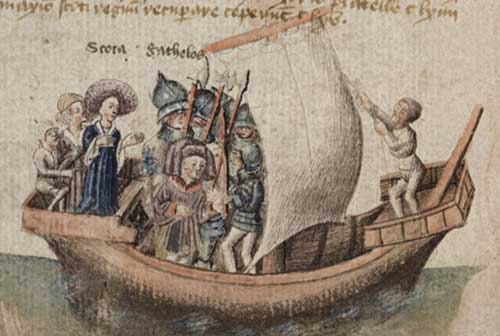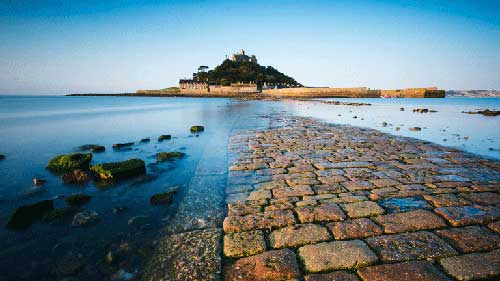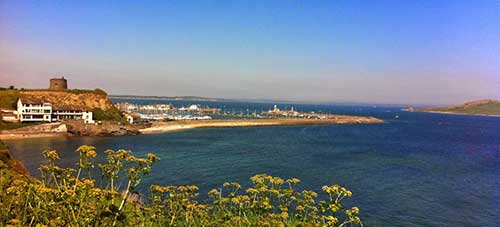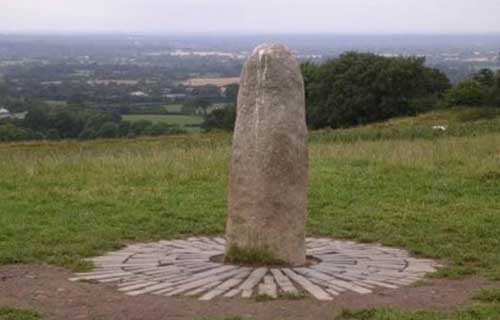
Editor's Note: the following discourse is not necessarily based on proven fact, but relied heavily on myths that are said to be based on historical fact. They provided here for information only and are not included in this series of studies as factual evidence in support of conclusions drawn in it.

Historical records and the Book of Jeremiah (43:5-7) indicate that, at the fall of Jerusalem in 588 BC, the prophet Jeremiah and (possibly) the family of the king escaped to Egypt, which included a princess, Teia Tephi. This uprooting and (later) planting (in another country?) done by Jeremiah, is ssen by some to fulfil God's prophecy through Ezekiel in chapter 21:26 where God promised to: "exalt him that is low (line of Zarah - Eochaidh) and abase him that is high (line of Pharez - Zedekiah)."
The Book of Tephi is said to have been written by Teia Tephi, the daughter of the king of Jerusalem whom escaped from Jerusalem with Jeremiah in 588 BC at the fall of Jerusalem and the kingdom of her father, Zedekiah. The Book describes in detail the journey Jeremiah took with Teia Tephi, The Lia Fail (Stone of Destiny) and The Ark of The Covenant from Jerusalem to Ireland, via Tanis in Egypt (as in "Raiders of The Lost Ark") then on to Gibraltar (where she was proclaimed queen of the Gadite Israelites who live there); Breogan in Spain; Cornwall and eventually landing at Howth, near Dublin, in Ireland on the 18th. of June 583 B.C.
The Book then goes on to describe many of the significant events which occurred at that time in history and are associated with her journey from Jerusalem to Ireland. It is also full of Prophecies about many of the major events which have occurred in the world between her and our time (2,500 years); including the First-Coming of Christ and the colonizing of the world by the British Empire. The Book also gives some very significant prophecies about the times we now live in.
Perhaps the most relevant of her Prophecies, which is the only one in "The Book of Tephi, queen of Tara and Gibraltar" that remains to be fulfilled, is about a time in history when she predicts that she would be recovered from her subterranean tomb on The Hill of Tara, in Co. Meath, Ireland; along with The Ark of The Covenant and once again bring peace and unity to all of Ireland as she had done two and a half thousand years ago; and that Christ would come out of her tomb with her, to be inaugurated King of all of Ireland, on the Stone of Destiny, at Tara, and this time, also bring peace and unity to the whole world. This is taken to be the fulfillment of God's Prophecies in The Bible Book of Genesis chapter 49:10 - "The sceptre shall not depart from Judah (the line of David), nor a law-giver from between his feet, until Shiloh (Christ) comes" .
Jacob-Israel had twelve sons, who fathered the Twelve Tribes of Israel. Israel's fourth son, Judah from whom the Jews claim descent and who sold his brother Joseph into slavery in Egypt, had twin sons called Zarah and Pharez, as is recorded in The Old Testament book of Genesis chapter 38:27-30.
When Judah's twins were about to be born, the midwife; who knew that there were twins in the womb; had prepared herself with a scarlet cord to mark the firstborn. Today the same thing is done with a plastic name-tag placed around a baby's wrist. Zarah (meaning 'Scarlet' in Hebrew) put his hand out of the womb first and the midwife tied the scarlet cord around his wrist to identify him as the firstborn. He then pulled his hand back into the womb and his twin brother Pharez was born first, thereby breaching his brother Zarah's birthright and so he was named Pharez which means 'Breach' in Hebrew.
Long before the birth of Teia Tephi; back in 997 B.C. under David's grandson Rehoboam, the son of Solomon; the twelve tribes of Israel fell out with each other and split-up into two separate kingdoms, with two separate kings and they lived side by side but in two separate countries, called Israel and Judaea. The twelve tribes divided into the ten-tribed "House of Israel" who lived in Israel in the northern section of the Holy Land under king Jeroboam and the two-tribed "House of Judah" who lived in Judaea, in the South of the Holy Land, under the sovereignty of Solomon's son, king Rehoboam.
The Northern kingdom was called Israel and its capital city was Samaria. The Southern kingdom was called Judaea and its capital was Jerusalem. The Jewish people claim their descent from the two-tribed "House of Judah", hence their name Jew.
Returning now to the story; Pharez, having taken the birthright from his brother Zarah, carried the tribal (family) name of Judah, from which came King David, the shepherd boy who slew the giant Goliath with a stone from his sling and became king of Israel. The Royal line of David descends from Pharez and their emblem is an amber/golden lion, rampant, with a crown on its head.
The descendants of his brother, Zarah of the 'Red Hand', having lost the Birthright, went into exile and migrated to Heberia (now known as Iberia or Spain). There they built the city of Zaragoza. Zaragoza (originally Zarah-gassa) means the "Stronghold of Zarah" and the city is still called Zaragoza today, even though the Israelites' traditional enemy, Babylon and Rome, invaded Heberia and drove the Zarahites out to the northern coastlands of Spain. From there many of them fled across the water to Ireland (Hebernia; the Hebrews' new-land and the Hebrides - Hebrew's Isles). Some of their descendants migrated from Ireland to Scotland, and, once there, decided to use their own Judah Zarah version of the Judahite emblem, which is the red lion rampant, just as Judah Pharez use the amber lion rampant (rampant is a word used in heraldry. and it means that an animal is shown standing-up on its back legs, on a coat-of-arms).
Centuries after Zarah first left Judea to go into exile abroad, and the ten-tribed "House of Israel" had been taken out of Israel, the northern kingdom, to Assyria as slaves in 722 B.C., Jeremiah the Bible Prophet was sent to king Zedekiah of Jerusalem in the southern kingdom to warn him to return to keeping The Covenant or God would punish the two-tribed "House of Judah", as he had previously punished the ten-tribed "House of Israel". Jeremiah warned king Zedekiah of Jerusalem that, if he did not keep The Covenant, God would send king Nebuchadnezzar of Babylon to lay siege to and destroy Jerusalem. Zedekiah ignored the warning and put Jeremiah in prison.
That did not prevent the prophecy from being fulfilled, it only made its fulfillment more certain. Nebuchadnezzar sent his army and laid siege to Jerusalem whose inhabitants became so hungry that they ate their own children. The City was not only taken but was also laid-waste and burned. The Holy Temple that had been built by Solomon and Hiram, was also destroyed, along with The City. Nebuchadnezzar released Jeremiah from prison and gave him free reign to do as he was commanded by God.
Zedekiah, who was descended from the royal line of David of the Pharez branch of the tribe of Judah, and all of his sons were captured and taken from Jerusalem to Babylon, where his sons were slain in front of Zedekiah's eyes and then he was blinded, so that the execution of his sons would be the last thing he ever saw. He himself died in prison, in Babylon.
The inhabitants of Judaea were taken captive and were removed from Judaea into Babylon to become slaves to their captors, just as the ten-tribed "House of Israel" had previously been taken off their land Israel and into slavery, before them. At the time Nebuchadnezzar was king of Babylon, the Assyrians were no longer the world super-power that had defeated the ten-tribed "House of Israel" and had themselves been defeated and driven-out of Assyria, so they were no longer in a position to keep the ten-tribed "House of Israel" as slaves and they all migrated to the North-West of the Holy Land. The Assyrians stopped in what is now called Germany and eventually became the Germans of today with their German Military Cross that is identical to the ancient Assyrian Knight's Cross. Finally being free from domination by the Assyrians, most of the "House of Israel" separated themselves from them and continued on their long trek, to the North-West coastlands and Islands, of what is now Europe, exactly as it was prophesied that they would do.
During the destruction of Jerusalem, by Nebuchadnezzar of Babylon's troops in 588 B.C., Jeremiah hid with Zedekiah's daughter Teia Tephi under The Temple, built by Solomon, in a cave where The Ark of The Covenant was hidden along with Jacob's Pillar (The Bethel/Lia Fail Stone) which is king David's Throne of Israel.
Baruch, Jeremiah's scribe then came and told them that the coast was clear, so Jeremiah took Teia Tephi and the Kingly Treasures and went first to Mizpah and then to Tahpanhes (Tanis) in Egypt for safety. There they stayed in a palace that was given to Teia Tephi by pharaoh Hophra after he adopted her as his own daughter. The palace, although now in ruins at Tel Defneh, is still known today as "Quasr Bint el Jehudi" which means "Palace of the Daughter of Judah".
The royal party stayed at Tanis for some time, until Jeremiah was warned that Nebuchadnezzar was about to invade Egypt and that they must leave. Jeremiah's group left Tanis on a moonless cloudy night, sailing in a ship of Tyre, piloted by a Danite called Buchi son of Helek, who was accompanied by his son Boedan, firstly to Carthage, where they arrived three weeks later, but did not disembark. At sunset a strong hot wind blew from the desert driving them North and Teiaring their sails. On the seventh day they entered a little bay by the mouth of an unknown river that ran from East to West; where they dropped anchor. They found they were in the Tiber Estuary near Rome and were advised by a local to keep travelling, which they did.
Jeremiah's group sailed to Gibraltar. There Teia Tephi was proclaimed queen, by the Gadite Israelites who had settled there. Teia found many of the inhabitants worshipping Melcarth / Neptune and condemned them for their idolatry. The travellers stayed there for five months. The group then travelled abord a Greek vessel, which was then sailed with the aid of Simon, the son of Elier the ruler of Gibraltar, who guided them across the Bay of Algeciras and through the Straits to Breogan in Spain, where he introduced them to Ith Cian, the Israelite ruler who, like the Egyptian pharaoh before him, adopted Teia Tephi as his daughter. Ith told them of his missing son called Lughaidh, who had sailed-off several years previously with his five ships and was presumed dead, but, unbeknown to them all, he was living in Ireland, where Teia Tephi and Jeremiah were heading.

St Michael's Mount, Cornwall
When they left Breogan, they headed for Ireland. After being blown North for several days in a storm, they sighted land and entered the bay at Mara-Zion, near St Michael's Mount in Cornwall. At Mara-Zion they met Elatha the powerful ruler of Cornwall, who was a kinsman of Ith Cian of Breogan and an ally of Elier bar Ziza of the Gate (Gibraltar). Elatha welcomed them and had their boat repaired for them. He then sent a message to the high king (Ard ri) of Ireland to say that Teia Tephi the queen of Jerusalem was coming and requested a guarantee of safe-passage for the queen.
When Teia Tephi and Jeremiah informed Elatha of the fall of Jerusalem he wept bitterly, so the name given to that place in Cornwall was and still is Mara-Zion, which is Hebrew not Cornish or English and means "Bitter for Jerusalem".
The Irish kings on receiving Elatha's message, sent back to him their reply, which was a message of welcome and many gifts of gold and silver to Teia Tephi to show her she would be safe and that they all sought her favour and some her hand in marriage. Eochaidh sent his family's most treasured heirloom; a piece of jewellery which is called the "Sun of Helen" (of Troy); that his sires had won as a spoil of war at the Battle of Troy, where his Zarahite ancestors and the Danite greek ancestors of the Irish people, including Ulysses, had built their famous Trojan horse, that had successfully fooled the Trojans and gained them access to their city.
After receiving their positive answer and invitation, Elatha sent his son Bressail, who was Nuadh, the king of Ulster's champion and fifty-three ships, with two thousand and five men, to escort Teia Tephi safely to Ireland.

Binn Eadair, Ireland
Teia Tephi arrived with her two handmaidens, at Penn Edair (Binn Eadair - Howth), near Ath Cliath (Dublin), in Ireland on the 18th June 583 BC. She was greeted there by Eochaidh, the High king (Ard ri - Heremon) and Ethan, the king's harper and good friend, between whom she was carried ashore and both instantly fell in love with the queen. Teia Tephi knew only the identity of the harper (Ethan) and didn't know that the other person carrying her was actually Eochaidh, the High-king, whom she was destined to marry. She stayed that night at the Fort of Crimthann, which was built on the top of Howth Hill.
Teia Tephi was then escorted to Cathair Crofinn (The Hill of Tara), where she arrived on 20th June 583 B.C. and was escorted to the house that had already been prepared for her there.
At Tara, there were a number of priests of the satanic Baal-religion who had erected a phallic-pillarstone as part of their worship of the mythical gods of pagan Baal fertility. Teia Tephi ordered that the obscene stone phallus be removed immediately and the Bethel Stone / Lia Fail (God's Throne of Israel) be put in its place on the Forrad (Inauguration Mound).
Eochaidh the Ard ri (High-king) arrived and introduced himself to Teia Tephi. Teia instantly recognised him as the one she had met at Howth and knew that they were destined to marry.
As Eochaidh was from the Zarah (of the 'Red Hand') branch and Teia Tephi was from the line of David of the Pharez branch of Judah, their marriage-union sealed the "breach" caused centuries earlier when Judah's twin sons had been born. This marriage-union, that took place at "Rath na ri" (the Fort of the kings) at Tara, in Royal Meath, is symbolised on the Ulster flag, where the 'Red Hand' of Zarah is mounted upon the 'Star of David' under the single Royal Crown, symbolizing the union of the two royal lines, that sprang from Judah.
Teia Tephi had a palace built at Teltown (near Kells), where she lived with Eochaidh and had four children named Aedh, Ainge, Aengus and Cermad. Aedh, her firstborn son, died whilst still a teenager and his body was placed in the eastern side of Teiamur (Tephi's Wailing Wall - now known as The Mound of The Hostages) at Tara, so she could weep over his grave while she wept over the fall of Jerusalem. In 1955 the Irish archaeologist Sean P. O'Riordhain found Aedh's skeleton, still wearing Egyptian beads that had been given to his mother Teia Tephi, by pharaoh Hophra, when he adopted Tephi as his own daughter during her stay in Egypt, before she came to Ireland to be its queen.
Tephi's second born was a girl named Ainge who grew up to marry Nuadh's grand-son, Ethdan, who became the chief of the Miledh. Her third child was a son she named Aengus, who was brought up by Eochaidh's sister, Maistiv in Mullagh, Co. Cavan. Aengus succeeded his parents to the Throne. He had the grandest tomb in Ireland constructed for himself to become immortal in, when the Winter Solstice sunrise entered his tomb. Part of his wish was accomplished, by his being immortalised in human memory for his magnificent tomb at Newgrange, which is confirmed by the hieroglyphics "written in stone" on Stone C4 in the West Recess inside of Newgrange, where his name Aengus is written in Ogham Script. Not much is known about Cermad, Teia Tephi's youngest son.

Lia Fail Stone, The Stone of Destiny
The Lia Fail Stone that Teia Tephi brought with her from Jerusalem stayed in Ireland, on the Forrad (Inauguration Mound), at Tara, for more than a thousand years and all of the Irish kings were crowned upon the Stone up to c. 500 A.D. It was then loaned to Fergus, the brother of Muircheartach (Murdoch) king of Ireland, who had emigrated to Scotland and wanted to be crowned king of the Irish who had settled there and had become Scottish.
The Stone was not returned to Tara and stayed in Scotland, where it was called the Stone of Destiny (English for Lia Fail) and all of the Scottish kings were crowned upon it, until 1296 A.D. when Edward the first of England "Longshanks" invaded Scotland; defeated the Scots and took the Stone, from Scone Abbey near Perth, to London where all of the English kings were subsequently crowned in Westminster Abbey upon the Stone of Destiny, up to, and including, George the Sixth. In 1950 four Scottish Nationalists removed the Stone from Westminster Abbey; took it back to Scotland and a replica stone called the Stone of Scone was later placed at Arbroath and from there it was taken to London. It was this same stone that Elizabeth the Second was crowned upon in 1953.
All of the Irish; Scottish and English monarchs after 583 B.C., including Queen Elizabeth II, are descended from Eochaidh and Teia Tephi of the line of David from the tribe of Judah.
Teia Tephi left many prophecies in her autobiography, 'Book of Tephi'. The book was restored; translated into English and originally published in 1897. At the beginning of chapter 31 of her Book, Teia Tephi prophesied that the last overturn of the Throne, to Christ, would happen on the 2,484th anniversary of her death, in 534 B.C., which calculates to 1950, when four Scottish Nationalists removed the Stone of Destiny from Westminster Abbey and returned it to Scotland.

Design by W3layouts